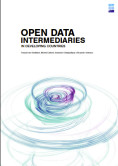Web Foundation: “….data intermediaries are undertaking a wide range of functions. As well as connecting data providers (for example, governments) with those who can benefit by using data or data-driven products, intermediaries are helping to articulate demand for data, creating and repackaging data, and creating novel applications. In Nepal for instance, intermediaries play a range of roles, from running the government open data portal, to translating complex data sets into formats that are easily understood by a population that is largely offline and suffers from low literacy levels.
How are intermediaries connecting data providers to end-users?
To answer this question, French sociologist Pierre Bourdieu’s social model, in particular his concept of species of capital, was used as a lens. According to Bourdieu, capital is not only economic or material. We use other symbolic forms of capital like social capital (e.g. friends and memberships) or cultural capital (e.g. competencies and qualifications) in our social interactions.
Unsurprisingly, the study found that most open data intermediaries use their technical capital to connect to data providers (97%). However, to fulfil their role of not only connecting to data providers but of facilitating the use of open data, open data intermediaries require multiple forms of capital. And because no single intermediary necessarily has all the types of capital to link effectively to users, multiple intermediaries with complementary configurations of capital are more likely to connect data providers and users.
 A model of layers of intermediaries connecting a data source with users
A model of layers of intermediaries connecting a data source with users
….Of the 32 intermediaries studied, 72% can be described as not-for profit and, as a consequence, rely on donor funding to sustain their operations. This has significant implications for future sustainability.
What are some of the key conclusions and implications of the study?
- Intermediaries are playing a critical role in making data truly useful.
- The presence of multiple intermediaries in an ecosystem may increase the probability of use (and impact) because no single intermediary is likely to possess all the types of capital required to unlock the full value of the transaction between the provider and the end user.
- Working either alone or in collaboration with others, intermediaries must go beyond technical capital to unlock the benefits of open data – using social, political or economic capital too.
- Governments would do well to engage with a broad spectrum of intermediaries, and not simply focus on intermediaries who possess only the technical capital required to interpret and repackage open government data.
- Given that intermediaries are presently largely donor funded, in the short term, funders should ask whether possible grantees possess all the types of capital required not only to re-use open data but to connect open data to specific user groups in order to ensure the use and impact of open data.
- In the medium term, different funding models for intermediaries may need to be explored, or the sustainability of civically-minded open data initiatives could be at risk….
ACCESS THE FULL REPORT:
 Open Data Intermediaries in Developing Countries
Open Data Intermediaries in Developing Countries
By François van Schalkwyk, Michael Caňares, Sumandro Chattapadhyay & Alexander Andrason
